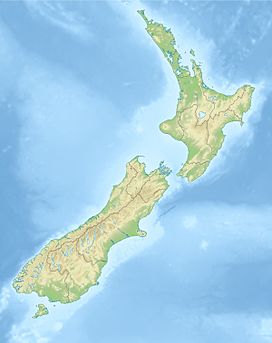Haast Pass
| Haast Pass | |
|---|---|

Gates of Haast
|
|
| Elevation | 564 m (1,850 ft) |
| Traversed by | State Highway 6 |
| Location | New Zealand |
| Range | Southern Alps |
| Coordinates | 44°06′19″S 169°21′22″E / 44.105278°S 169.3561°ECoordinates: 44°06′19″S 169°21′22″E / 44.105278°S 169.3561°E |
Haast Pass is a mountain pass in the Southern Alps of the South Island of New Zealand. It is named for Julius von Haast, a 19th-century explorer who was also geologist for the Provincial government of Canterbury. The pass was used by Māori in pre-European times, but not on a regular basis.
It is one of the three passes where a road crosses over the Southern Alps, the other two being Lewis Pass and Arthur's Pass, although the Homer Tunnel also passes under the Main Divide. The road through Haast Pass (State Highway 6) was converted from a rough track to a formed road in 1966. and finally received a complete tarmac surface by 1995. In the early 20th century, a railway from the West Coast through the pass to Otago was considered; it would have linked the Ross Branch with the Otago Central Railway, which then terminated in Omakau. However, the line never came to fruition; the Otago Central Railway terminated in Cromwell and no railway was built south of Ross, just a lightly laid bush tramway to serve logging interests near Lake Ianthe.
The Haast Pass rises to a height of 562 metres above sea level at the saddle between the valleys of the Haast and Makarora Rivers. As such, it is the lowest of the passes traversing the Southern Alps. The Haast Pass road is devoid of any settlements between Haast and Makarora. The road passes through predominantly unmodified beech forest. The pass itself is within the limits of Mount Aspiring National Park and forms part of the boundary between Otago and the West Coast.
...
Wikipedia

